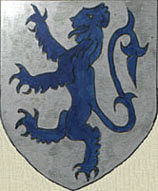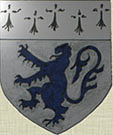|
Sword Dancing in the 1900's.
|

Lingdale Sword Dancers in 1965.
Back - Frank Holmes, Bill Hill, Dick Hogarth, ?, Bill Husband.
Front - Dougie Morel, Wilf Hopper, Alan Moody.
|
MEMORIES OF A NORTH SKELTON PIT DEPUTY.
Frank Holmes, the last Deputy out of North Skelton Mine in 1964, [see page 58 of Skelton Stories] was a member of the Lingdale "Primrose" Sword-dancers in the late 1950s and 1960s.
He moved to Skelton and work at North Skelton when Lingdale pit closed down in 1958.
He recalls a sword-dancing team being re-started in Lingdale, when one Billy Knight had meetings with Major Pennyman of Ormesby Hall in the 1930s. This ties in with other recorded facts in the History of our area.
The true origins of Sword Dancing are lost in time and probably date back to our Anglo Saxon and Viking ancestors.
It is often associated with a play, in which it is the instrument of Death and derives from the age-old drama of death and resurrection.
Some say it had connections to pagan religions like Sun worship.
Traditionally it is danced in mid-Winter and possibly connected with the decay and rebirth played out by the Seasons.
Frank says that he was always told that it had associations with work on the land, threshing etc and we see the same connection in the name of the nearby Goathland Plough Stots team.
|
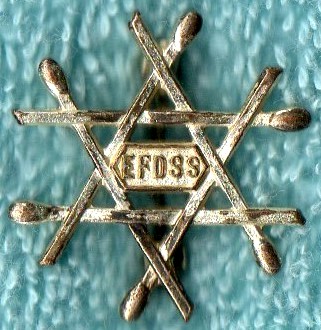
Frank's badge of the English Folk Dance and Song Society.
|
In England the dance survives in two forms, the Long Sword, which comes from Yorkshire and is still fortunately carried on in different places in the County and the Rapper, which is a faster dance and comes form Northumberland.
The Long Swords used by the Lingdale team were made from Miners' worn out drills, about 2' 6" long, a wooden handle at one end, a blunt tip and no edge.
Franks says that the Lingdale team always practised at the "top 'ouse", i.e the Lingdale Tavern, as no doubt it was very thirsty work.
The team had six dancers, a reserve and 2 fools.
The fools, in clown's dress, in some versions dance around the "knot" of sword dancers.
In the Lingdale team's performance they were ritually "executed" at the end of the dance by putting there heads in the centre hole formed by the locked swords and "decapitated" as the weapons were withdrawn.
The dance had six separate parts or "movements"
Teams elsewhere could number from 5 to 8.
Being a Sword Dancer involved devoting a good deal of time to the cause. Frank says that apart from practising the team demonstrated their expertise "wherever they were wanted" locally and danced as far away as Birmingham and 3 times at the Albert Hall, London.
Frank particulary remembers performing at Eston Hospital, when, just after they had finished Harry Dockeray, one of their team, just dropped down dead.
Some teams took collections. At Lingdale in Frank's time it was all for love.
They provided their own dress of black shoes, navy blue trousers, white shirt and black tie. On the tie they wore a large badge of locked swords and around the waist a cummerbund of the team's colours.
|
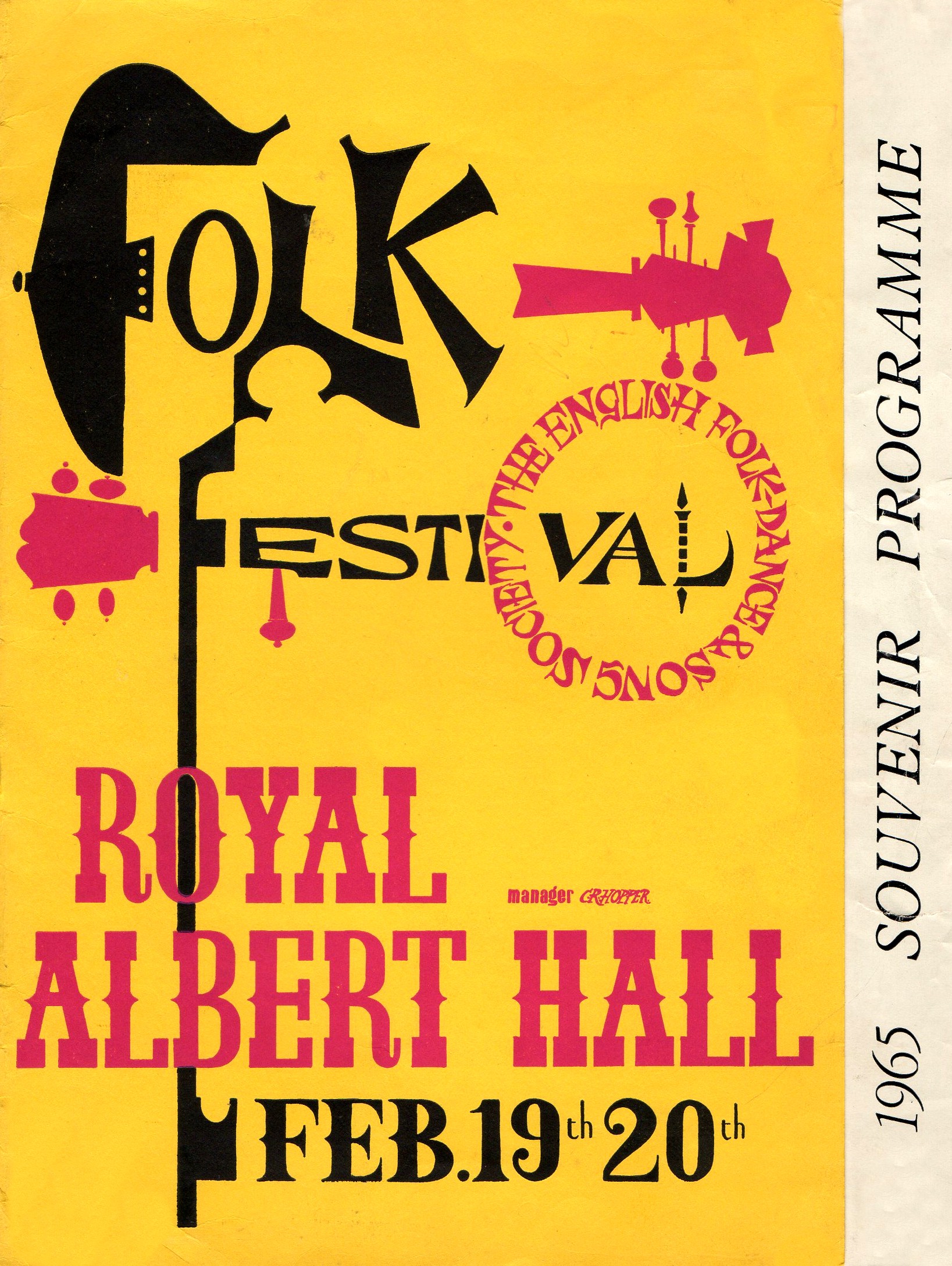
Frank's Souvenir Programme of performing at the Albert Hall.
|
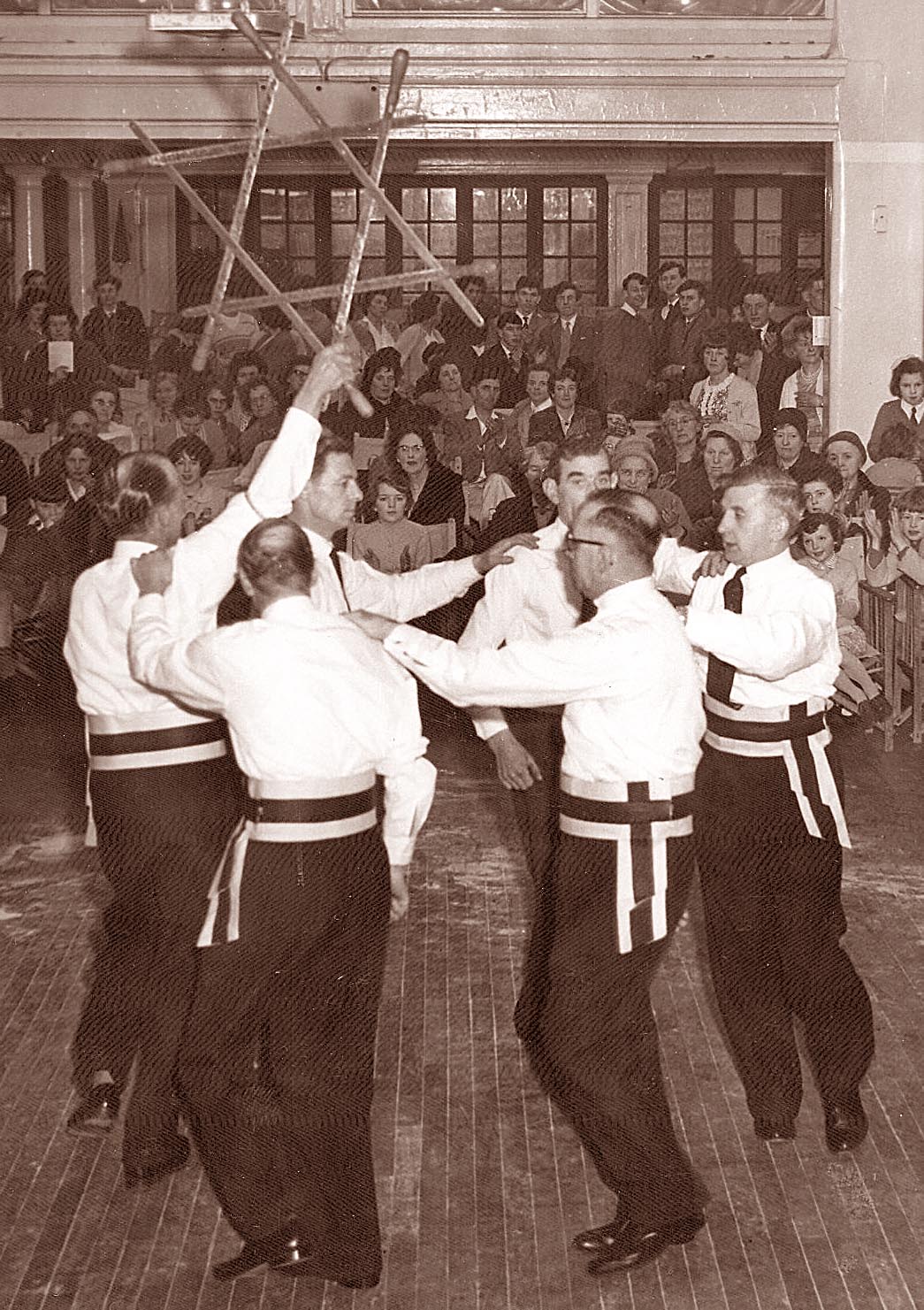
Lingdale Sword Dancers at Whitby Spa.
Frank Holmes, far Right and clockwise, Wilf Hopper, Harry Dockeray, Alan Moody, Dougie Morel and Bill Husband.
|
The team's accordion player was Frank's Uncle, Richard "Dick" Hogarth, who later was the proprietor of the Ship Inn, Brotton, where the team also practised.
Frank says that Dick played a wide variety of tunes, as long as the beat was right, from "Abide With Me" to the twist tunes of Chubby Checker in the 60's.
ROLF GARDINER,
A RIDE ON THE OLD COASTAL RAILWAY LINE AND A VISIT TO NORTH SKELTON.
In 1923 Rolf Gardiner, a Southerner, wrote a book on English Folk Dancing, but was unaware of the Sword Dancing tradition of this area, where North Skelton were one of the few places that still had a performing group.
It had certainly been going strong in 1905 as the photograph on this page shows.
At that time North Skelton Sword Dancers were described as:-
"Two men dressed up like clowns each with money boxes and 3 or 4 more to keep the company alive.
The dancers wear white linen bloused with a 3 inch band of turkey-red linen round neck and a similar one round the shoulders - like a cape; red cuffs.....a band of red down the middle with large pearl buttons.
A soldier's round pork-pie hat of dark colour with a band of red and yellow, a small looking glass rather larger than a crown, fixed in front, and a strap under the chin.
Ordinary dark trousers with a red stripe. Bells down the outside of the legs and on arms."
In 1925 Gardiner travelled North to see the dance performed. The following is his rather ornate description of the journey on the North Yorkshire coastal railway line [passenger service ceased operation in 1958] and his visit to North Skelton Band Room.
One reaches North Skelton by the coastline railway, which runs beyond Scarborough and Whitby to the mouth of the Tees.
It traverses the curving wolds that interpose themselves between sea-cliff and moorland waste, with insweeping bays of pasture and many rushing becks tunnelling the groins of the hills, beneath stunted oaks and hazels.
|
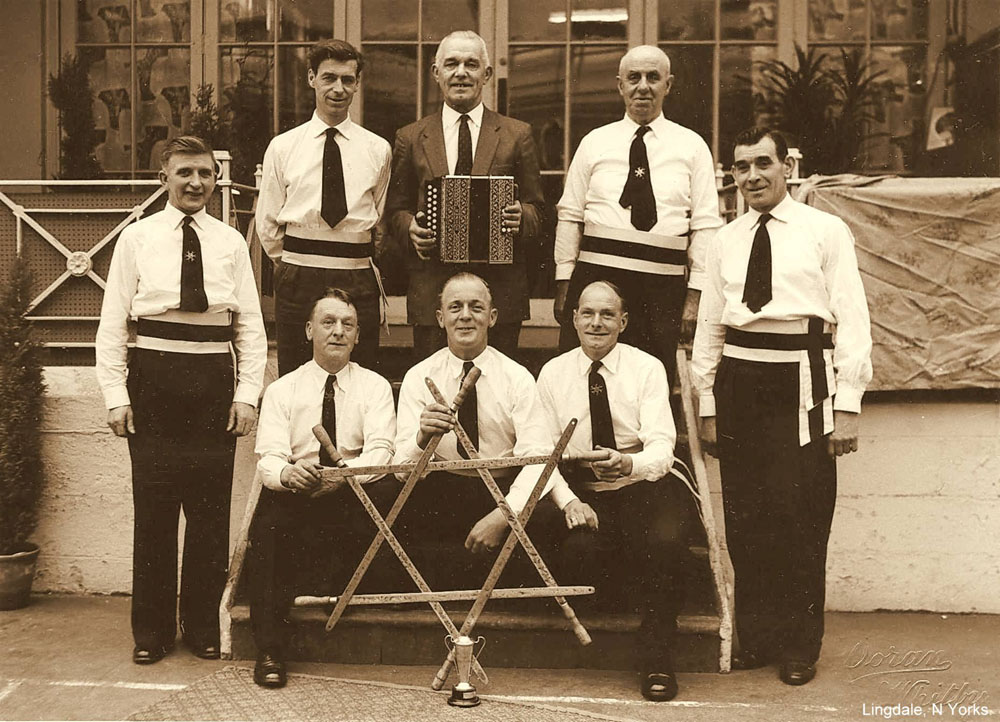
Lingdale Sword Dancers.
L to R Back. Frank Holmes, Dougie Morel, Dick Hogarth, Bill Hill, Bill Husband.
Front. Harry Dockery, Wilf Hopper, Alan Moody.
|
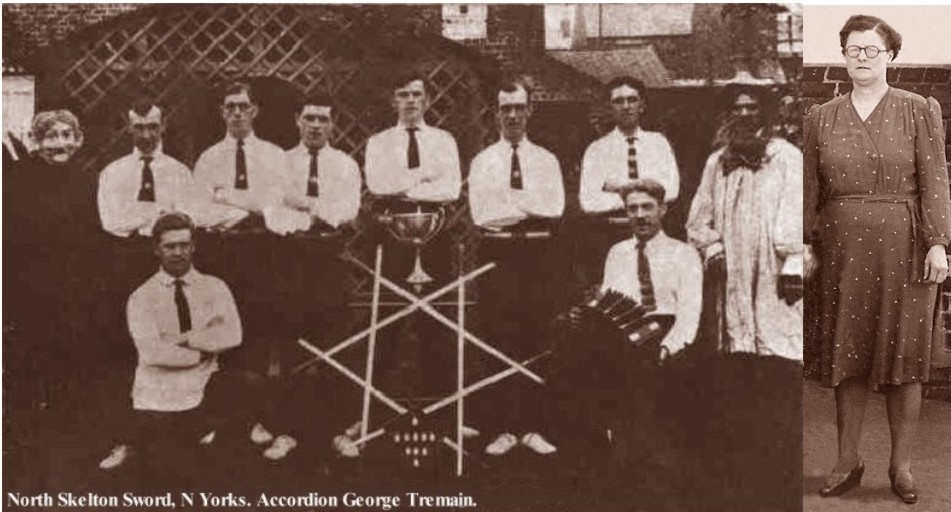
North Skelton Sword Dancers.
|
Set in the sheltered places of this tumbled landscape crouch farms of swart, dark-grey stone capped with roofs of vermilion red.
The railway trails through tunnels in these wolds, leaping the becks along high bridges while every now and then it darts towards the sea-cliff to look down on some miniature harbour town clustered in its bay, a haven for mariners, invaders and smugglers since the day of the Norsemen.
Finally it enters the industrial region below Saltburn, under up-cast slag-heaps, towering blast furnaces emitting tongues of green flame, factory chimneys spewing forth soot and past squalid mining villages of dark red brick.
We came to North Skelton at that magical season of the year, in the days shortly before Christmas towards the winter solstice.
The day was bleak and cold. Snow lay in streaks upon the dun and bistre-coloured fields and in dirty patches upon the clayey road.
Flocks of starlings passed low overhead and to seaward cormorants flew oblivious on thier coastal business.
|
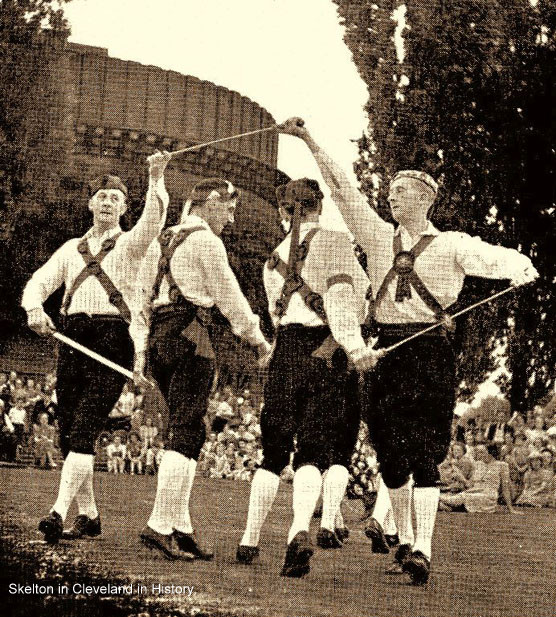
North Skelton Sword Dance displayed at the Stratford Festival.
This photograph, with the above caption, appeared in the December 1946 issue of the 'Dancing Times', kindly contributed by Susan and David Holt of Little Melton, Norwich.
|
We came under a railway bridge, crossing a ravine of dark rocks and then past a vast fuming ironworks, the sound of hammering and of trucks clanking along the metals in our ears.
The mining township lies among the pit-heads not far from the sea.
In a short back street we entered the local Bandroom, a hut of timber-framing and corrugated iron, plain and bare, save for the instruments in their worn covers and an iron stove radiating warmth.
About three o'clock the Miners came in, one by one, or in pairs, unobtrusively, quickly.
They were all neatly dressed, with clean white scarves about the throat and cloth caps.
Since six in the morning they had been in the pits, the shift was over at two.
They were distinctive types of men, with interesting individual faces and were very quiet, hushed, a curious expectant light in their eyes.
One jaunty-looking fair-haired man, a blend of Cornish and Dane, carried a box containing his accordion, another held the swords, shining steel weapons, beautifully tempered, about forty inches long and very heavy.
[Owen Rooks who lived in New Skelton in the 1940s suggests that the "jaunty, fair-haired man" could well have been a young George "Townie" Tremain, who played the melodeon for the village sword dancers seemingly for the rest of his life.
He is shown on the photograph here with the North Skelton White Rose Sword Dancers.
The lady is Mrs Readman, a Teacher at North Skelton School, who used to coach them in the period after the War.
North Skelton School used to perform at Carlin How Institute in an East Cleveland Schools Country Dancing Competition and Owen remembers George also playing the melodeon for them.
The Band-room that Gardiner described has been replaced by a coloured, corrugated metal structure which still stands in the same location at the the lower end of the rear of William Street, adjacent to Railway Terrace.
It was used by North Skelton Silver Band until around 2005, but sadly they have re-located to Nunthorpe and the building is neglected and surrounded with weeds.
A local resident explains:-
"A lot of the street houses in North Skelton and New Skelton have been bought up and let out.
|

North Skelton Sword Dancers early in the 1900s.
|
This has resulted in people moving in from outside the area.
Drug taking is rife and the community spirit has disappeared.
This has led to the “new” Band-room being vandalised. It is now boarded up and abandoned. It is thought the building still belongs to the band, but no one seems to know for certain."]
The 1911 census shows that George Tremain would have been 27 when Gardiner first came to North Skelton.
George's father, John, was in fact a Cornish man, who had come to this area for work in the Ironstone Mines and married a local Guisborough lass, Emily.
They had 15 children, but only 10 survived. In 1911 George was 13 and his brother Fred, a year older, was already working down the Mines as a Horse Driver. George was soon to follow him.
The family lived at 1 William St, North Skelton with 9 children, aged from 1 to 21 still at home.
Amazingly in a two up and two down terrace house they still found room for a 27 year old Lodger.]
Presently they took off their coats and stood in their white shirts and black trousers that reached rather high up the waist.
Each wore a black tie neatly fastened with a gold badge.
|
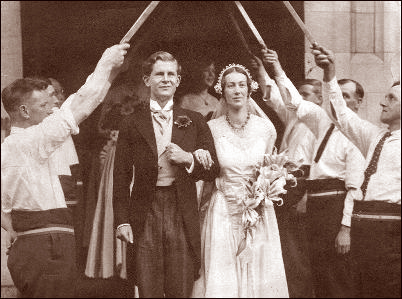
North Skelton Sword Dancers form a Guard of Honour at the wedding of Rolf Gardiner in 1932.
|
Then they took up their swords, feeling them from end to end, partly as if to regain familiarity with their shape and weight, partly as if to test them.
A stillness almost reverential came over them.
The musician held his accordion on his knees. He gave a sly, sidelong glance at the dancers, then drew out the concertina with one long deep note like a mighty breath.
The men were looking up towards the tip of their swords, concentrated.
The tune came suddenly, quickly, passionately. The dancers were away in a flash, stepping round in a circle, clashing the swords above its centre, a glinting cone of metal in movement.
The effect was electrifying. The quick emphatic, urgent music, an impassioned assault of sounds and the steady measured, absolutely controlled movement of the dancers - it was this contrast which was so hypnotic to the beholder,
the storming passion of the music and the perfect restraint and controlled rhythm of the dancers.
They kept it up in a lilt which was neither a trip nor a trot nor a run, but a loose-jointed fall of the foot from ball to heel, the knees slightly flexing, the feet as it were consciously feeling for the ground, as though they were magnets drawing up out of the earth's dark centre some essential power.
The upper half of the body is steady, the torso held as if rigid, but not stiff and always turned inwards towards the circle's centre with the eyes fixed in an almost sightless concentration on the middle of the ring, the whole effect being of a smooth wheeling, while the feet move on, falling from beat to beat.
Now, dancing in this ring, the dancers linked hilt and point, each man turns and steps over
|
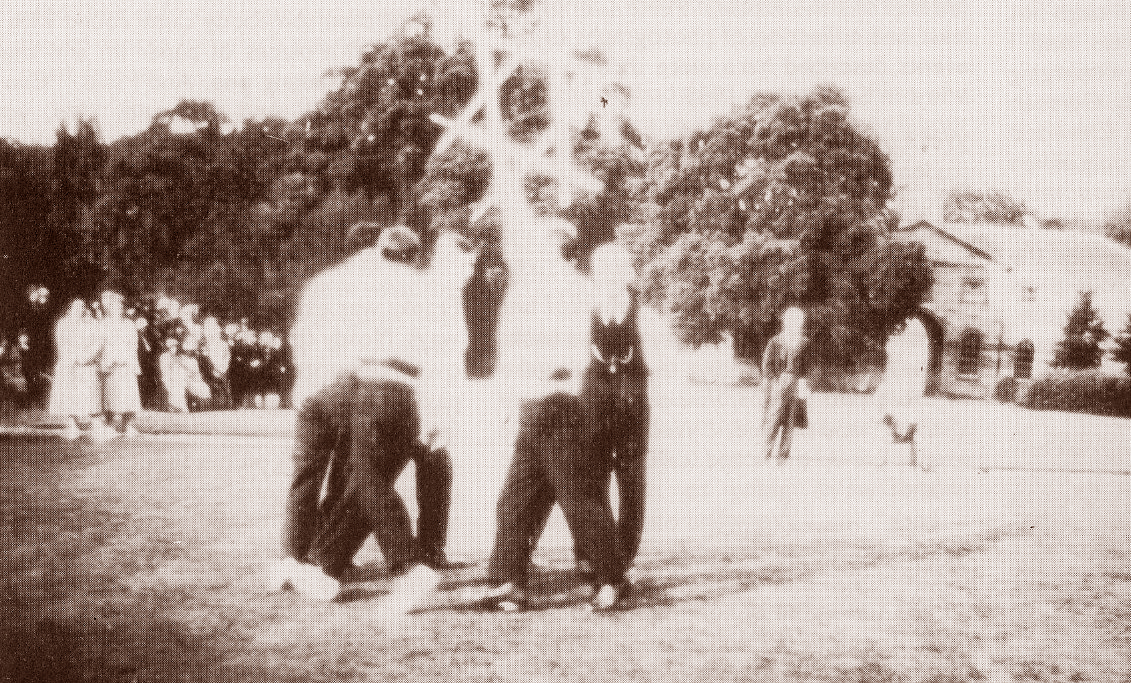
North Skelton Sword Dancers at Ormesby Hall in 1931.
|
his neighbour's sword held low in front of him, but in so smooth and subtle a fashion that the perfect on-flowing progress of the circular
movement remains unimpeded.
Then the dancers pass two and two under an arch formed by the remaining couple, the fight repeated, each couple raising the lintel in turn.
Suddenly the swords are swept out of the ring into the "low basket", points downward to the centre. There they are held in a hush, while the music quietens, so that above it is heard the rhythmic tread of the feet.
Comes a crescendo, the swords are clashed low to the ground.
Then suddenly the ring is closed, the swords being swiftly crossed and wreathed into the "lock".
The "lock", the hexagonal wreath of interlaced swords is held aloft by the leader as the men tread onwards in the circle, then it is lowered, the dancers seizing the hafts of their swords.
Each man placing his free hand on the outer shoulder of the man in front, the team moves in a compact knot, speeding to a trot.
With lightning swiftness the swords are torn fiercely from the lock, the dance halts and the first "movement" is ended.
|
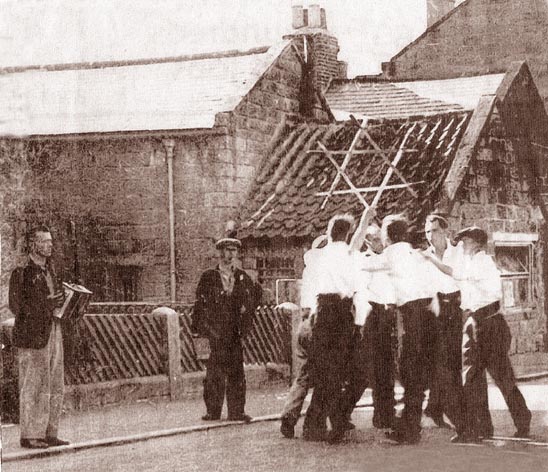
Lingdale Sword Dancers in 1936 at George Myers Farmhouse, Stanghow. The Accordion player is Dick Hogarth and the man with the collection box is Bill Hill, who danced with the team for 40 years. He lived next door to Frank Holmes for a number of years in Coral Street, Lingdale in the shadow of the man-made mountain that was the shale heap there.
|
REVIVAL OF SWORD DANCING IN EAST CLEVELAND 1925 TO 1939.
Gardiner's enthusiasm was passed on to the Pennymans at Ormesby Hall and other Cleveland notables.
Between them they instigated a revival of interest in Sword Dancing and similar cultural activities in the North Riding of Yorkshire.
Ruth sponsored the formation of the Lingdale "Primrose" team. It was the middle of the Depression, when unemployment in this area reached over 90 percent. The Miners had just elected the area's first Labour MP, Billie Mansfield.
Whether the Lingdale dancers realised their team's name was the emblem of the Conservative Party is not known.
Other teams were established at Loftus and Boosbeck and a second one at North Skelton.
At the same time Gardiner and the Pennymans were involved in trying to provide work for the unemployed Miners of the area and rented land off Skelton Castle Estate to create the gardening schemes at Heartbreak Hill/Margrove Park, Dartmoor/Margrove Park and Busky Fields/Lingdale. [see page for 1927 to 1935.
].
In the Summer of 1931 Ormesby Hall and Rounton Grange, the home of the Bell family, who had made their fortune in the Ironstone mining boom, were used as a rehearsal centres for a tour by performers of folk music.
Morris dancers came from Dorset, where Rolf Gardiner was also an estate owner.
A German youth choir from Frankfurt and a German puppet theatre were brought over.
Altogether 58 performances were given in the East Cleveland towns and villages, including Skelton in Cleveland.
This cultural connection to other parts of the UK and Germany was continued in the efforts to provide work for the great many unemployed Miners of the area.
British and German students were encouraged to come and help in the clearance of the rough
|
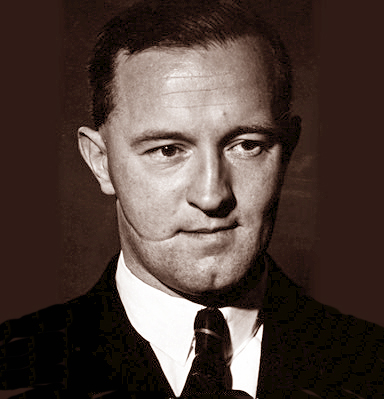
William Joyce -Lord Haw-Haw.
|
land that had been chosen for the gardening and live-stock keeping projects and while they were there to take part in the musical and
cultural discussions and events.
A torch-lit performance of Morris and Sword dancing was given on the Promenade at Saltburn by Sea.
Exchange visits were arranged for English and German performing groups and both North Skelton and Lingdale Sword Dancing teams visited Germany in 1936, the year of the Berlin Olympics.
LORD HAW-HAW.
In 1935 a party of German Miners visited East Cleveland and stayed with the sword dancers of Lingdale and their families.
Gardiner wrote:-
"For the German Miners the reception in the homes of their Yorkshire friends was undoubtedly the crowning moment of their tour.
These simple Yorkshire families spared themselves no effort to make them welcome in an expression of genuine warmth.
The entire village shared in spirit and acts of hospitality.
The menfolk met together to drink and sing.
Everyone joined in the local Brotherhood gathering on Sunday.
|
Major Pennyman, of course, entertained the Germans at Ormesby.
On the last evening there was a party organised by the miners and their wives, at which every kind of old-fashioned dance and polonaise was performed with tremendous gusto.
The gathering broke up at midnight with speeches and "Auld Lang Syne", the German Anthem, the Horst Wessel Lied and "God Save the King"."
Frank Holmes remembers a story about this.
It has always been said in these parts that one of the students who worked at Heartbreak Hill, Margrove Park was William Joyce, who achieved notoriety during the Second World War by broadcasting on the radio for the Germans.
His scornful messages mocking Britain's efforts made him one of the most hated of men in the UK and he was named Lord Haw-Haw.
|
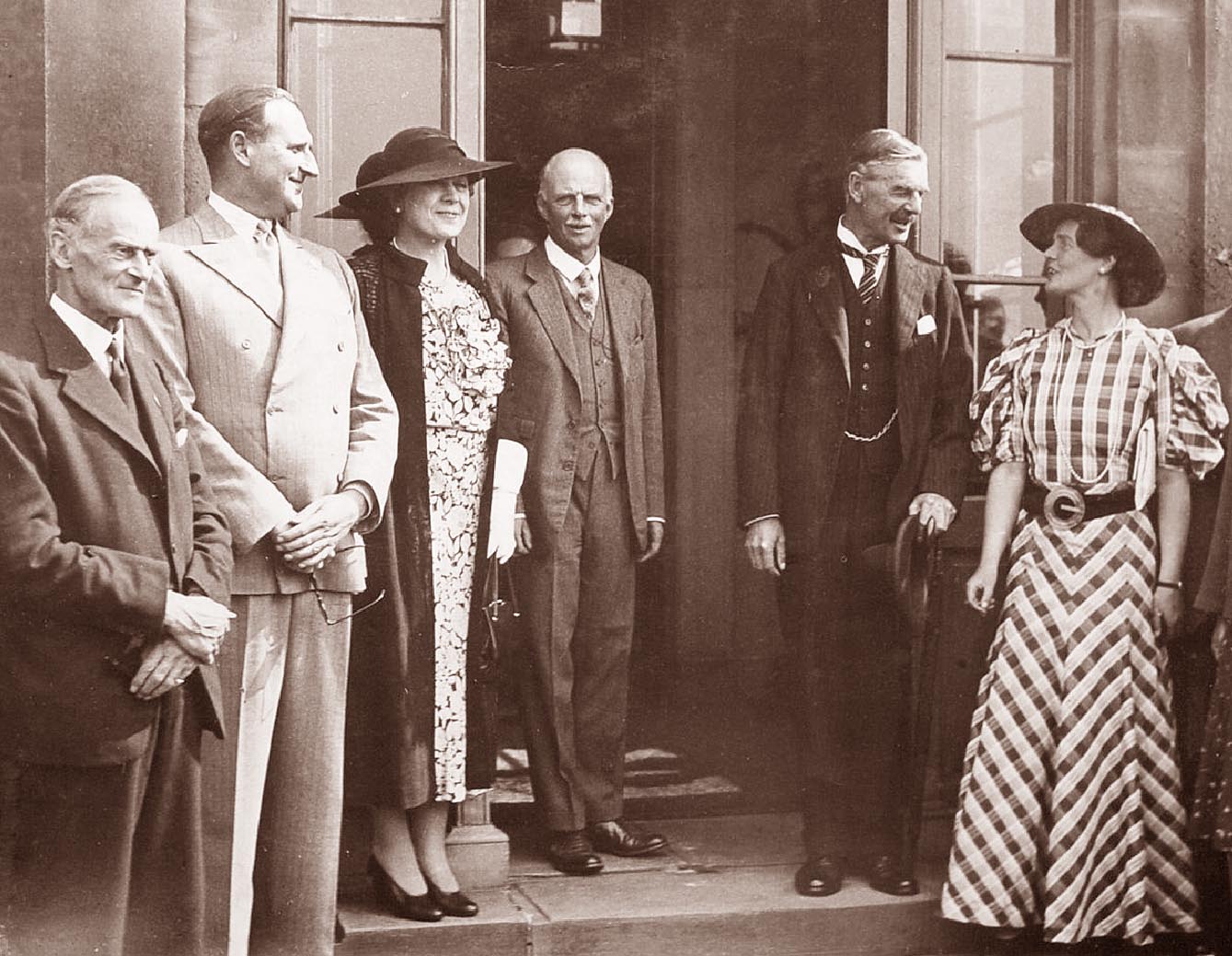
Ormesby Hall. From the Right, Ruth Pennyman, Neville Chamberlain [PM 1937 to 1940], Colonel Jim Pennyman.
|
He was hanged as a traitor at Wandsworth Prison in 1946.
There was a tale in Lingdale that Lord Haw-Haw had said that the Germans would never bomb Lingdale,
as the people had treated their German visitors so well in the 1930s.
Possibly no one told Goering and his Luftwaffe. Or maybe they were such precision bombers that they contrived to miss Lingdale a couple of time by less than a mile, when a fire bomb landed at Lockwood Beck and an explosive in the field down Stanghow Road where the old Quakers Cemetery was located.
HIDDEN AGENDAS - NAZI AND COMMUNIST "TOFFS".
The mass unemployment that hit the World after the First World War led to some radical ideology to solve the impossible enigma of how a self-seeking tribal monkey, like Man, can live together in continuous peace and prosperity in an ever shrinking World.
It was a time that saw the rise of extreme Socialism and Nationalism at one and the same time.
Ruth Pennyman, amateur writer and poet, for all her champagne life-style at Ormesby Hall, fancied herself as a bit of a Communist.
It brings to mind many of today's Labour politicians who preach Equality, as long as they have a
|
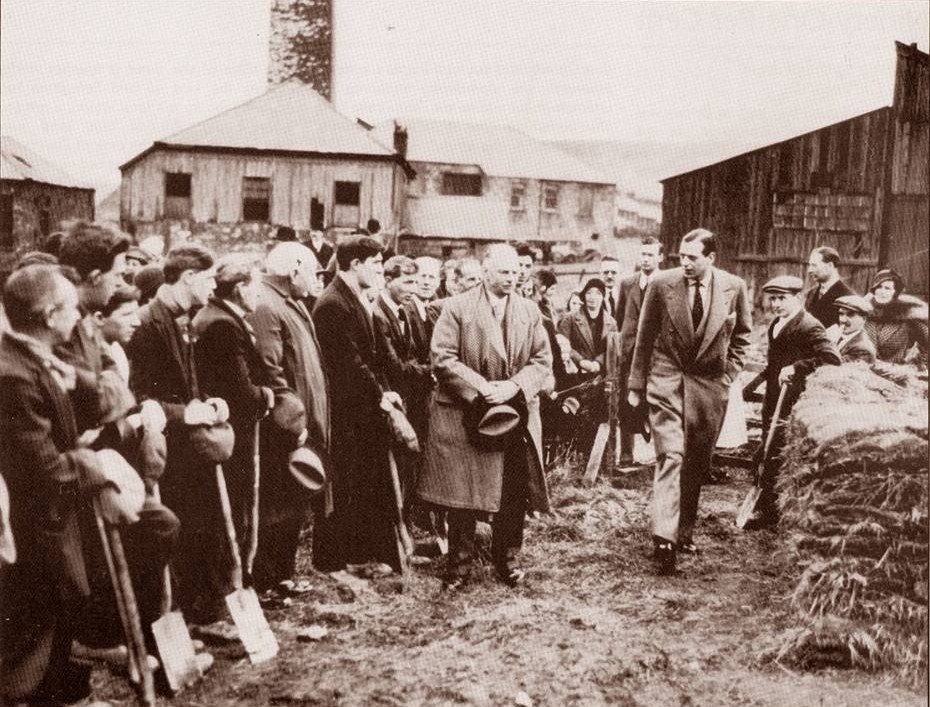
Major James Pennyman and George, Duke of Kent, at Margrove Park old mine buildings on their way to inspect Heartbreak Hill on the 16th February 1933.
|
chunk more than anyone else.
- George Orwell was actually writing about the Pigs of Animal Farm at this time.
To give Ruth her credit she was responsible for saving children in the Spanish Civil War and was more the typical tender-hearted, female do-gooder than a political revolutionary.
Rolf Gardiner's philosophy was more sinister and in some ways as airy-fairy as his flowery writing style.
He was born in Fulham, spent some of his early years in Berlin and later educated in England.
He envisaged a pact of Northern races and culture, which mirrored Nazi Germany's ideas of a master-race and anti-Semitism.
He considered that a “Jew-controlled press, cinema, wireless and advertising,” had “corrupted the soul of England”.
He wrote a letter dated April 25th 1933 to Hitler's Minister of Propaganda, Goebbels styling himself as the “Fuhrer of a young English generation”.
Goebbels was not slow to use this as proof of British backing for Nazism.
To Gardiner the revival of a "Northern culture" and joint work groups was an attempt to politicize British youth.
He was one of the original "Greens" and practised Nudism. A bit chilly in Boosbeck.
He thought the population of Britain should turn away from urbanisation and return to the land - seemingly to become a Nation of swastika-waving, bare-arsed "Gardiners".
|
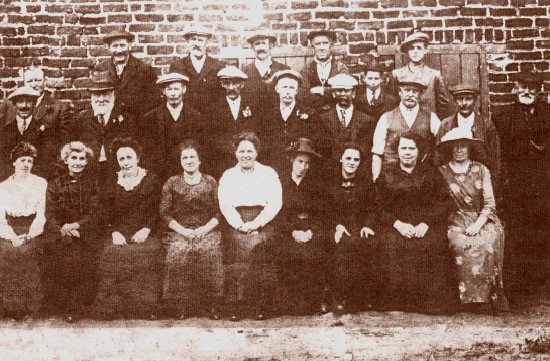
Group of Boosbeck villagers about 1922-26.
[Photograph kindly contributed by Margaret O'Shea of Oxford.
For some reason it has acquired the title of "Soup Kitchen", but it seems more like a celebration of some kind, with the menfolk wearing button-holes.
Margaret's Grandmother is the lady with the big lace collar, third from Right, in the front row.
The lad on the far Right of the Back row is Harry Peel, who was killed in a mining accident in 1929, aged 19.
The man in the middle of the Back row is his father, James Peel.]
|
It never really "took off".
It is unlikely that local people had any idea that they were supposedly being manipulated by social and political plotters.
Just existing from day to day in a world of soup kitchens engaged them enough.
In fact, many people in this area with bitter memories of the losses of the First World War, when nearly every family had had someone killed or mutilated, gave the Germans a wide berth.
Major, later Colonel, Jim Pennyman was a bit of a piggy in the middle, searching around to save his privileged old world order that the First World War had shattered and smelling Socialist revolution in the rise of the Trade Unions and Labour MPs.
He too in the 1930s voiced vague sympathies with Nazi Germany.
He was a Londoner, who had had a distinguished Army career as an Officer in India and then served in the First World War.
His first wife, Mary, whom he had married in 1915 died in 1924.
In 1925 he is recorded as a single Farmer travelling on a Banana boat to Kingston, Jamaica.
The next year he is making the trip with his second wife, Ruth.
Their often extreme political views were not unique at the time in a Britain of Hunger Marchers, Communist sympathisers and Mosley's Black-shirts parading as close as Middlesbrough.
Adolph Hitler's evil actions in the Second World War seems to have shown the ideologists where extreme Nationalism leads and brought them to their senses.
The people who came out of the depression with credit were the people that they had tried to exploit, the ordinary folk of East Cleveland, who only wanted the chance to work hard for their families - and dance.
A visiting Southern student afterwards recalled:-
|
"They certainly made a lasting impression on me.
The visits to Boosbeck, the squalor of the little houses, the poverty and deprivation of the unemployed were unforgettable.
And so were the people themselves, standing up to the insult of a society which had thrown them on the scrap heap with an independence of spirit and a sense of humour that amazed me."
|
|
